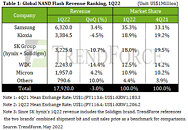
Micron Announces $40 Billion Investment in Leading-Edge Memory Manufacturing in the US
Micron Technology, Inc., one of the world's largest semiconductor companies and the only U.S.-based manufacturer of memory, today announced its plans to invest $40 billion through the end of the decade to build leading-edge memory manufacturing in multiple phases in the U.S. With the anticipated grants and credits made possible by the CHIPS and Science Act, this investment will enable the world's most advanced memory manufacturing in America. Micron expects to begin production in the second half of the decade, ramping overall supply in line with industry demand trends.
Micron's planned investment, the largest in memory manufacturing in U.S. history, will ultimately create up to 40,000 new American jobs including approximately 5,000 highly paid technical and operational roles at Micron. The Micron investment will also enrich surrounding communities by bolstering education, workforce training, transportation and several other services. Micron is finalizing its specific U.S. expansion plans and will share additional details in the coming weeks.
Micron's planned investment, the largest in memory manufacturing in U.S. history, will ultimately create up to 40,000 new American jobs including approximately 5,000 highly paid technical and operational roles at Micron. The Micron investment will also enrich surrounding communities by bolstering education, workforce training, transportation and several other services. Micron is finalizing its specific U.S. expansion plans and will share additional details in the coming weeks.






































